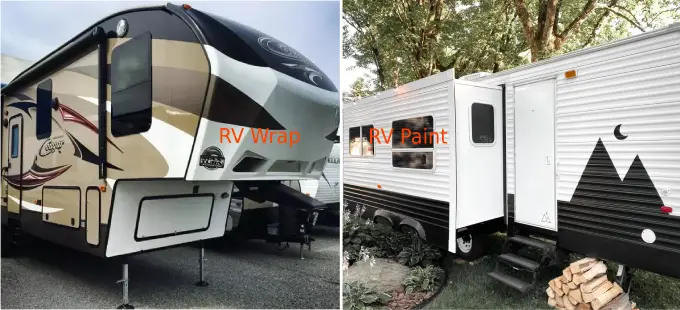Last Updated on April 5, 2023
Are you looking for a way to change the look of your RV? Look no further. You have two great options for making your RV look unique: painting or wrapping it.
Painting offers more options in terms of color and finish but is more expensive, while wrapping is faster to install and more budget-friendly but with fewer choices in terms of customization.
Below, we’ll take a look at the advantages and disadvantages of each option. By the end, you should have all the information you need to make an informed decision about which is suitable for your RV. So let’s dive in.
RV Wrap vs Paint: In Details
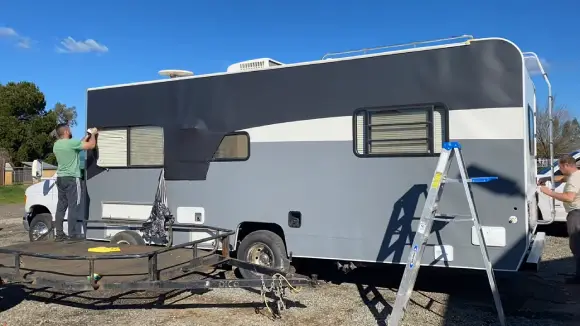
Advantages of RV Wrapping
RV wrapping is an excellent choice for transforming your recreational vehicle. It’s a process that creates a full vinyl wrap, which not only makes your RV look great but also offers several advantages over traditional paint. Let’s take a closer look at the advantages of RV wrapping.
Speed and Cost Efficiencies:
RV wrapping is much faster than traditional painting methods and can be completed in just one to three days, depending on the size of the RV. This means you can get back out on the road much more quickly. Additionally, it’s much more cost-effective.
Since it involves applying large sheets of vinyl to the vehicle’s surface instead of using expensive painting supplies such as primer, clear coat, and paint, you can save a lot of labor costs.
Variety of Designs and Colors Available:
With traditional painting methods, there are limited color options available, and any unique designs must be hand-painted with brush or airbrush techniques.
However, when you opt for an RV wrap, there are almost limitless design possibilities thanks to the variety of vinyl wraps available in different colors and textures. You can select from many pre-made designs or work with a professional designer to create something custom that shows your personality.
Easy to Clean and Maintain:
Traditional paint requires regular waxing every few months to maintain durability and shine. However, with an RV wrap, this is not necessary. Vinyl wraps are incredibly easy to clean; all it takes is a quick wash with mild soap and water or just plain water alone.
Moreover, vinyl wraps are resistant to fading due to the UV protection built into them, so they will continue looking great for years with minimal maintenance required from you.
Durable and Resistant to Fading, Cracking, Peeling, or Chipping:
Another significant advantage of RV wrapping compared to traditional paint is that it’s incredibly durable and resistant to fading due to built-in UV protection and cracking, peeling, or chipping since it’s covered with a thin sheet of plastic rather than exposed paint, like traditional painting methods.
This means that your RV won’t need touch-ups any time soon, making this option highly cost-effective over time as well.
Protection from Weathering and UV Rays:
The addition of a vinyl wrap also provides superior protection against weathering damage caused by extreme temperatures and UV rays, something that traditional paints simply can’t offer due to their lack of thickness when applied during the painting process.
Using a vinyl wrap, especially one designed specifically for outdoor use, you’ll be able to protect your recreational vehicle from damage caused by harsh environmental conditions like heat or cold weather extremes.
More Eco-Friendly Than Traditional Paint:
Vinyl wraps are also far more eco-friendly than traditional paints because they don’t require hazardous chemicals or volatile organic compounds (VOCs) during the application, as many paints do.
Not only is this safer for our environment, but it also reduces exposure risks associated with VOCs for both workers installing the wrap as well as yourself when living inside your wrapped recreational vehicle.
Extended Vehicle Life Expectancy:
A vinyl wrap is a great way to protect your recreational vehicle from the weather and keep it looking good. It can help stop damage caused by hot or cold temperatures and UV rays.
Plus, it lets air flow around the surfaces of your vehicle, so you don’t have to worry about needing many repairs as often. It’s a really good investment.
Disadvantages of Wrapping RVs
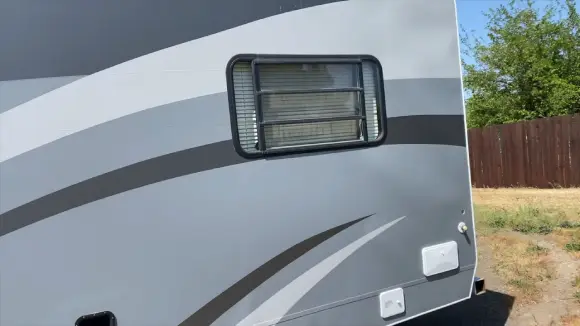
If you’re considering wrapping your RV, you may be wondering if there are any disadvantages to this option. Wrapping an RV can have drawbacks, and you’ll want to be aware before deciding whether the process is proper for you. Here’s a look at some of the cons of wrapping an RV.
Fewer Choices in Terms of Customization
Compared with painting a vehicle, there are fewer options for customizing an RV wrap. While customizing paint jobs is almost limitless and has been used for decades in automotive culture, wrapping is still relatively new and therefore limited in terms of what can be done.
Many companies offer basic shapes or designs on their wraps, but customization, such as airbrush or color blending, is not usually available. This means you might not find precisely what you’re looking for if you want something truly one-of-a-kind.
Not As Long-Lasting As Painted Finish
Another disadvantage of wrapping RVs is that they don’t last as long as a painted finish. Wraps typically fade over time due to exposure to the elements and need to be redone every few years, depending on how much wear and tear they receive.
As with all forms of vehicle customization, regular maintenance will help prolong the life of the wrap, but ultimately it won’t last as long when compared with painting a vehicle.
In addition, wraps are subject to weather damage, such as cracking in extreme temperatures, which could require more frequent replacements than an RV painted with traditional automotive paint would need.
Aspects of Appearance:
Finally, no matter how well installed it might be, there’s always a chance that an RV wrap won’t look as good as desired upon completion without professional help. Even then, you might struggle with air bubbles or wrinkles due to improper application, which could ruin your vehicle’s overall appearance.
Plus, because wraps come in limited colors and patterns, it doesn’t offer very much in terms of customization compared to traditional paint jobs, which makes it harder for people who want something truly unique for their vehicle’s exterior design.
Advantages of Painting an RV
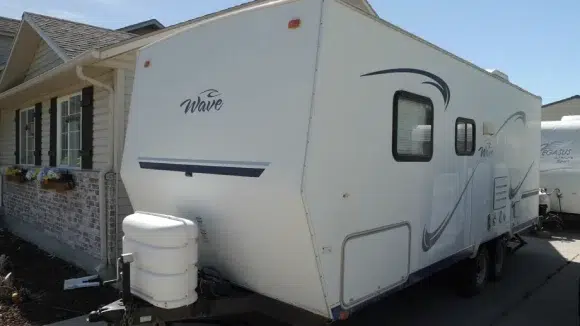
Painting your RV can be a great way to customize it, make it last longer, and even repair small areas without having to re-wrap the entire vehicle. Let’s look at some of the advantages of painting your RV.
More Color Options for Customization:
Painting your RV provides you with a much more comprehensive range of color options than wrapping it, allowing you to personalize your recreational vehicle truly.
With paint, you can choose any custom color that fits your style and will allow you to stand out from the crowd on the road. You can also use more intricate designs and techniques when painting compared to wrapping, so you can make your RV unique.
Better Long-Term Durability:
Painting your RV allows for better long-term durability if you take proper care of it. This is because paint helps protect against sun exposure which fades vinyl wraps over time, as well as cracking or peeling from minor scrapes and bumps that can happen while on the road.
Additionally, paint does not collect dirt or debris in crevices like vinyl wraps do, which makes for easier cleaning and maintenance.
Easier to Repair Small Areas Without Having to Re-Wrap the Entire Vehicle:
If any minor scrapes or dings occur while driving around in an RV that is wrapped, then you may need to re-wrap it entirely, depending on the size of the damage. On the other hand, if your vehicle is painted, then these repairs are much more straightforward.
Only needing touch-up paint or spot treatments rather than redoing all the work associated with wrapping an entire vehicle again. This also reduces costs associated with repairing damages since there is no need to pay for a full wrap job due to minor blemishes.
Finally, painting an RV has many advantages, including more color options for customization, better long-term durability if taken care of properly, and more accessible repair options without having to re-wrap the entire vehicle if damage occurs on the road.
If done correctly and taken care of properly, then painting an RV can be a great way to enhance its appearance and provide extra protection against wear and tear.
Disadvantages of Painting RVs
It’s essential to understand the potential drawbacks of this project before diving in. It requires more preparation than wrapping and can be more expensive depending on the type and brand of paint used. Here are some of the disadvantages of painting RVs.
More Preparation Than Wrapping
Painting an RV requires significantly more time and effort for preparation than wrapping does. This includes sanding down surfaces, cleaning them thoroughly, applying primer, and taping off any parts that need to stay free from paint.
All these steps are necessary for achieving a good finish, but they can take days or even weeks, depending on the size of the RV.
Expense
The expense associated with painting an RV can vary depending on things like the quality of paint being used and if there’s any professional help required. In general, higher-quality colors tend to cost more than wraps do.
Additionally, hiring a professional painter often costs around $500 for every 12 hours of work, meaning it could get very costly quickly if you’re not careful about budgeting correctly for this project.
Durability
Another disadvantage to painting your RV is that it isn’t as durable as wrapping when exposed to weather conditions or environmental elements such as dirt, debris, rocks, and other objects that could strike it while driving down the road.
Paint will chip away much more quickly than wrap does due to its thinner nature, so this should be taken into account when considering this option for your vehicle.
Overall, painting an RV has some significant advantages, like customization and personalization but also some major drawbacks.
It requires more preparation than wrapping does, can get expensive quickly depending on the type of paint used, and may not be as durable over time when exposed to outside elements during travel or storage period.
Factors to Consider When Choosing Between Wrap and Paint
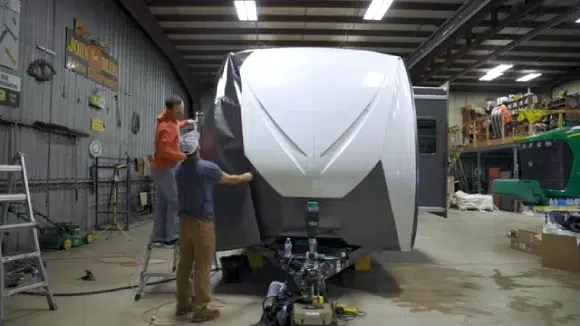
Choosing between the wrap and paint when customizing a vehicle can be challenging. Both have advantages and disadvantages, and depending on the individual’s needs, one option may be more suitable.
To make an informed decision, it is essential to look at the cost differences between wrap and paint, the time commitment required for each process, the level of maintenance needed for each method, how long your choice will last, and which option gives you the best look that fits your style.
Budget: Cost Differences Between Wrap and Paint
Considering cost differences between wrap and paint, consider both the material and labor costs. For wraps, most of the price is based on material because they require fewer labor hours to install than paint jobs.
However, if you cover an entire vehicle with a wrap, labor costs can still be relatively high, as it takes some skill to ensure it is done correctly. Paint jobs typically require more materials due to extra coats of primer or sealant needed before applying color coats.
The labor required for painting a car is much greater due to all of these extra steps that need to be completed first over those required for wrapping a vehicle. Generally, wraps tend to have lower overall costs than paint jobs, but this depends on several factors, such as the type of wrap used and the total coverage area.
Time Commitment: How Long It Will Take To Complete Each Process
Since wraps require fewer labor hours than paints does not necessarily mean that it will take less time overall for completion; factors like weather conditions must also be taken into account when estimating completion timescales for either process.
Wraps usually take around 1-2 days from start to finish, whereas a complete paint job can take anywhere from 4-7 days, depending on the complexity of the design or color scheme chosen.
Aside from installation time, there may also be additional delays due to weather conditions; either too hot/humid or too cold/wet could affect drying times which could impact completion timescales significantly in both cases.
Maintenance Requirements: Which Method Will Require Less Frequent Upkeep?
Wraps don’t need as much maintenance as a painted car. They can last longer but must be washed regularly to keep them looking good and protect them from the sun. Painted vehicles should also be waxed regularly, which helps protect them from minor scratches and UV rays.
But it won’t stop any big damages from accidents or collisions on the road. Different types of paint might require other cleaners, so make sure you know what kind of product is best before you try to clean it yourself.
Longevity: Will Your Choice Last As Long As You Need It To?
In terms of longevity, both wraps and paints offer different levels depending on your choice; matte wraps tend to last longer than gloss ones due mainly to their increased resistance against UV damage caused by sunlight exposure over extended periods (typically 3-5 years).
Similarly, certain types of paints, such as powder coatings, offer superior durability compared with ordinary liquid coatings (which can last up 2 years before requiring repainting); again, this depends heavily on where the vehicle is kept/driven (e.g., city driving vs. highway driving) so make sure you consider this when making your decision.
Aesthetics: Which Option Gives You The Best Look That Fits Your Style?
Ultimately aesthetics should play an essential role in deciding which option gives you the best look that fits your style; do you prefer bold colors with intricate designs or something simpler?
While some people prefer glossy finishes, which tend to be achieved through painting processes, others might opt for matte/satin looks obtained through vinyl wraps instead ultimately; it comes down to personal preference here, so make sure you get a good idea about different options available before making any final decisions.
Can you just paint the RV walls?
You can paint the walls of your RV to give it a fresh look. It takes some time, but it can be worth it. Before you start painting, sand the walls lightly and then clean them with a damp cloth. Once they’re dry, apply primer and let that dry completely before adding any color.
Add 1-2 coats of paint and wait for them to dry before putting on more coats. Use good quality brushes or rollers for an even finish to look great when you’re done. With patience and proper preparation, you’ll have beautiful results that will last for years.
Is RV full-body paint worth it?
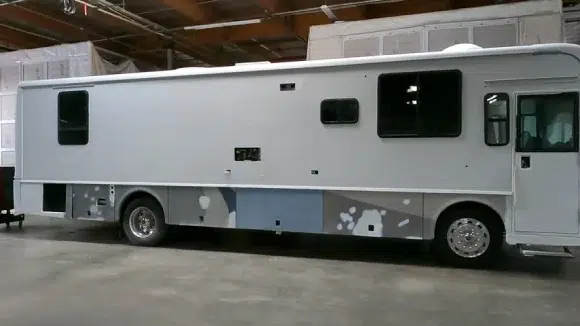
Full body paint is an option for customizing your RV. It can make your RV look unique, and it helps protect it from fading or peeling. Plus, it’s easier to clean than vinyl wraps.
However, full body paint can be expensive and take a while. Vinyl wraps may be faster and cheaper, but they won’t last as long. Whether you choose full-body paint or vinyl wraps depends on your needs and budget.
Does vinyl wrap add value?
Vinyl wrapping your car can add value and protection. It’s cheaper than getting minor paint repairs, and you can customize the look without changing the vehicle. Quality wraps that are installed and looked after properly will ensure you get a good return on your investment.
Plus, it might even increase the value of your car because it preserves the original paint underneath. So if you want to give your vehicle a new look while protecting its color, vinyl wrapping is worth considering.
Does a paint job last longer than a wrap?
Painting a car is better than wrapping it because it can last several years. The length of time you get out of the paint job depends on the quality and condition of the painted surface. Usually, you should expect your paint job to last between 5-10 years before needing any touch-ups or redoing it.
Wraps generally only last 3-5 years, and they don’t protect as much from UV rays and other elements that could damage your car’s exterior over time. Painting offers more longevity, but both have advantages depending on cost and durability.
Do wraps destroy paint?
Worrying is unnecessary, but it can cause damage if not installed correctly. Vehicle wraps are vinyl and act as a protective barrier between the paint and weather exposure, rocks, and other elements that can harm your vehicle’s paint job.
However, if the wrap is left on for too long, it can lead to adhesive bonding with the surface and cause damage to the paint. It is important to make sure you have an experienced professional install your wrap to prevent any potential damage.
Protect Your RV with a Stylish Makeover
Painting and wrapping your RV can be great ways to protect it from weathering and UV rays while also giving it a stylish look. If you’re looking for speed and cost-efficiency with a wide range of designs and colors available, then RV wrapping is the way to go.
However, painting gives you more color options for customization that can last longer if properly cared for. Ultimately, the choice between wrap vs. paint comes down to budget, needs, and preference, so consider all these factors before making a decision.

